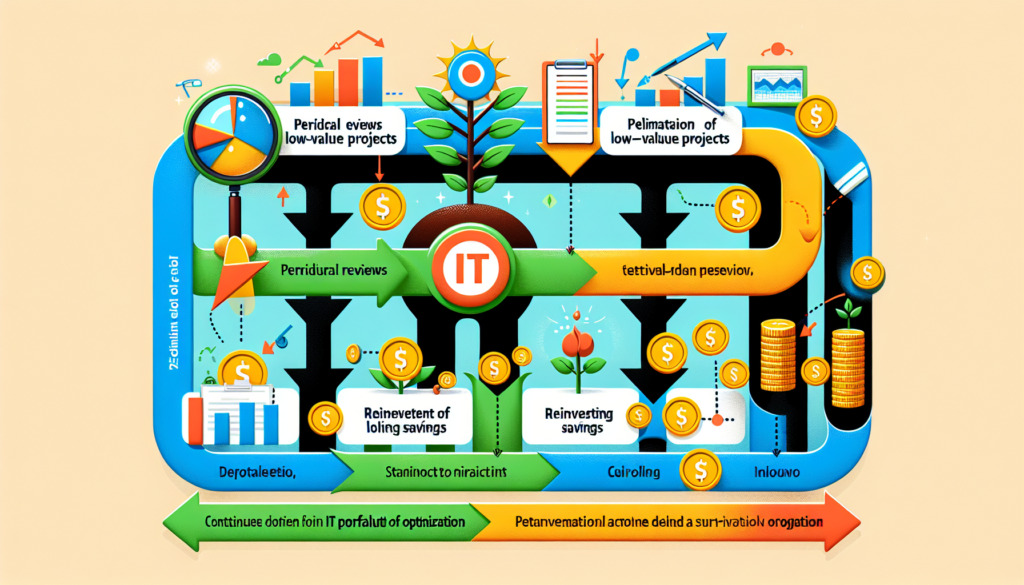Want to avoid wasting money? Stop wasting money: The Ultimate Guide to Optimizing IT Investments for Maximum Impact will show you how to optimize your IT investments for the greatest impact. Discover actionable steps to assess your current IT landscape, cut unnecessary expenses, and align your IT resources with your business objectives. Enhance efficiency, reduce costs, and drive growth with our proven strategies.
Key Takeaways
Assessing the current IT landscape is essential for identifying inefficiencies and aligning IT investments with business objectives.
Establishing clear business objectives and KPIs ensures IT projects are aligned with strategic goals, maximizing their value and impact.
A robust evaluation process, effective vendor management, and a culture of innovation are critical for optimizing IT investments and driving long-term business success.
Assessing Your Current IT Landscape
Evaluating your current IT landscape is the initial step in optimizing your IT investments. This involves eliminating waste, scrutinizing investments, and boosting project success while enabling IT change. Organizations often face a non-integrated, incohesive view of their IT investments, leading to inefficient spending on technology solutions.
Continuous monitoring can help discover shadow IT and uncover inefficiencies, providing a clearer picture of your IT assets and their alignment with business objectives. Frequent evaluations can better align IT with business objectives and identify potential cost savings.
Conduct a Comprehensive IT Audit
A thorough IT audit provides a clear understanding of your organization’s IT assets. IT asset management (ITAM) accounts for the deployment, maintenance, upgrade, and disposal of assets throughout their lifecycle stages: planning, procurement, deployment, maintenance, and retirement. Many IT managers lack an integrated, cohesive view of their investment portfolios, making it difficult to evaluate performance effectively. Roadmaps can assist by helping evaluate business resources and uncovering IT overlaps, which can lead to significant savings and improved efficiencies.
Enterprise Architecture and SaaS Management tools are instrumental in discovering the existence of On-Prem and SaaS applications and their business unit associations. Consolidating data centers, for example, can lead to savings of 10% to 20% of the overall data center budget while improving efficiencies. Continuous monitoring ensures assets are effectively utilized and aligned with business objectives.
Identify Redundant Systems and Applications
Recognizing redundant systems and applications is vital for cutting IT costs and enhancing efficiency. Application rationalization can quickly reduce IT costs by identifying and removing redundant or non-value-adding applications. Shadow IT, which refers to unmanaged and undocumented applications or services installed without company knowledge, can lead to potential redundancies. Detecting and removing duplicate or unnecessary systems can significantly cut costs and boost efficiency.
Lifecycle stage, usage, business value, and risk can help rationalize applications and identify overlaps. Decommissioning old technology and upgrading current systems maintains efficiency and reduces redundancies. Consolidating similar consulting projects can also provide greater efficiency and reduce costs.
Map IT Resources to Business Capabilities
Linking IT resources to business capabilities optimizes resources and supports strategic objectives. Aligning IT assets with business capabilities helps identify redundancies or gaps, revealing the actual business value. Business capability maps and enterprise architecture tools can be utilized to visualize and align IT processes with business goals. This alignment ensures that IT investments are directly supporting the business strategy and driving value.
Predictive analytics helps businesses anticipate market shifts and customer preferences, fostering proactive investment strategies. By mapping IT resources to business capabilities, organizations can ensure that their IT investments are aligned with their overall business model and strategic objectives.
Defining Clear Business Objectives for IT Investments

Clear business objectives for IT investments guide them toward fulfilling the broader business vision. Establishing clear objectives helps ensure that IT projects are aligned with business strategy, maximizing value delivery.
Continuous IT portfolio optimization ensures technology investments align with evolving business strategies. Sharing data-driven insights with key stakeholders can facilitate better understanding and alignment around strategic decisions.
Set Strategic Objectives
Before: Strategic objectives are defined by setting specific, measurable goals that align with the overall business strategy. Specific, measurable objectives are vital for aligning IT investments with business growth. Key Performance Indicators (KPIs) should be specific, measurable, attainable, relevant, and time-bound (SMART) to accurately gauge the success of IT investments. These KPIs serve as measurable standards to assess the effectiveness of IT investments in achieving strategic goals.
After: Strategic objectives are defined by setting specific, measurable goals that align with the overall business strategy.
Specific, measurable objectives are vital for aligning IT investments with business units and specialized knowledge for business growth.
Key Performance Indicators (KPIs) should be:
Specific
Measurable
Attainable
Relevant
Time-bound (SMART)
These KPIs serve as measurable standards to assess the effectiveness of IT investments in achieving strategic goals.
Engaging stakeholders in defining and prioritizing IT investment goals ensures that the KPIs are relevant and accepted across the organization. Regular KPI reporting keeps stakeholders informed of IT investment performance and supports informed decision-making.
Prioritize High-Impact Projects
Prioritizing high-impact projects maximizes IT investment effectiveness. When organizations focus on projects that offer the highest return on investment, they are likely to see improved financial performance. Focusing on high-impact projects enhances IT investment returns, ensuring resources deliver the most value.
This approach helps eliminate wasteful spending and aligns IT projects with strategic business priorities.
Engage Stakeholders in Goal Setting
Involving key stakeholders in goal-setting ensures IT investment goals are relevant and effectively prioritized. Involving stakeholders helps align IT investments with the overall business strategy and strategic objectives, increasing the likelihood of project success.
This collaboration directs investments toward initiatives driving the most value for the organization.
Developing a Robust Evaluation Process
A robust evaluation process maximizes the effectiveness of IT investments. Clear governance policies facilitate effective decision-making and accountability within IT investments. Regular evaluations of the IT portfolio help identify potential optimization opportunities that may not be visible in day-to-day operations.
This involves establishing KPIs, implementing a scoring system for proposals, and regularly reviewing outcomes.
Establish Key Performance Indicators (KPIs)
Defining key performance indicators (KPIs) is crucial to assess IT investment success. Clear KPIs ensure IT investments align with business strategy and objectives. These KPIs should be specific, measurable, attainable, relevant, and time-bound (SMART) to accurately measure the effectiveness and return on IT investments. Continuous KPI assessment ensures IT investments deliver value and maximize effectiveness.
Regular KPI reporting keeps stakeholders informed and supports informed decision-making. Communicating insights gained from KPI evaluations effectively is vital for ensuring stakeholders understand findings and can make informed decisions based on those insights.
Implement a Scoring System for Proposals
A scoring system enables quantitative assessment of IT investment proposals. Clear evaluation criteria ensure proposals align with business objectives and can be objectively measured. This structured scoring system should consider multiple factors, including cost, benefit, and alignment with strategic goals.
Weighting each evaluation criterion helps prioritize proposals based on importance. This approach ensures that resources are allocated to projects that offer the highest potential impact and align with the organization’s strategic objectives, thereby enhancing overall productivity and focus on high-impact work.
Regularly Review Investment Outcomes
Regular review of investment outcomes maximizes their effectiveness and achieves strategic goals. Post-project evaluations help assess whether the intended value was delivered through the investment. Post-implementation reviews assess whether IT investments deliver anticipated benefits. This continuous assessment ensures that resources are utilized efficiently and adjustments can be made to improve long-term success.
Continuous KPI monitoring reduces risk and avoids losses on underperforming projects. Regular reviews on a consistent basis help in making informed decisions, ensuring that IT investments remain aligned with strategic goals and deliver maximum value.
Effective Vendor Management

Effective vendor management optimizes IT investments by reducing costs and improving service quality. Over-reliance on consultants erodes internal capabilities and increases costs.
To avoid this, organizations need to define clear roles for internal teams and consultants, actively manage vendor relationships, and establish clear communication channels for the entire organization.
Select Vendors Strategically
Strategic vendor selection involves choosing suppliers who provide high-quality services that enhance competitive edge and align with business strategy. Clear objectives before negotiations avoid misunderstandings and lead to better outcomes. Breaking complex contracts into simpler, manageable parts can facilitate agreement and reduce negotiation times.
Aligning vendor selection with strategic objectives reduces costs and enhances competitive advantage. This strategic approach ensures that vendor partnerships support the company’s long-term goals and enhance overall performance.
Negotiate Favorable Contracts
Favorable contract negotiation ensures mutual benefits and clearly outlines expectations and responsibilities. Well-structured contracts include terms to ensure cybersecurity measures, reducing risk and protecting the organization.
This approach ensures that both parties are aligned and that the services provided meet the business’s strategic goals.
Monitor Vendor Performance
Continuous vendor performance monitoring maintains productivity and manages delays. Regular assessments reveal compliance issues and highlight improvement areas. Establishing a clear point of contact with vendors streamlines communication and helps address issues promptly. Transparent communication channels with vendors are essential for maintaining productivity and managing delays.
Periodic reviews and audits of vendor relationships prevent financial discrepancies and fraudulent activities. Setting clear expectations and performance metrics, such as KPIs, helps to align vendor services with business needs and ensures that they contribute to the organization’s strategic goals.
Fostering a Culture of Innovation and Adoption

A culture of innovation and adoption drives IT investment success and ensures a competitive edge. A data-driven culture empowers employees to leverage data insights for informed decision-making. This approach enhances technology adoption and utilization across the organization, improving overall performance.
Promote an Innovative Mindset
Encouraging experimentation and adopting new technologies promotes an innovative mindset. Training programs ensure employees effectively utilize new technologies, enhancing skills and boosting confidence. Recognizing and rewarding teams and individuals who successfully implement innovative solutions fosters motivation and continuous improvement.
Fostering an innovative mindset reduces risk and provides a competitive advantage. This approach encourages employees to think creatively and embrace new strategies, driving long-term success and maintaining a competitive edge.
Provide Training and Support
Training and support equip employees with skills to effectively utilize new technologies. Innovation-focused training programs empower employees to effectively utilize new technologies. By including innovation in training material, organizations can ensure that employees are prepared to leverage new technologies successfully.
Empowered employees drive successful technology adoption and utilization across the organization. This approach ensures that employees are confident in their abilities and can contribute to the organization’s competitive advantage.
Reward Successful Innovation
Recognizing successful innovation fosters a culture of continuous improvement. Promoting an innovative mindset encourages individuals and teams to experiment with new ideas and technologies. Recognition and rewards increase motivation and enhance performance, driving long-term success.
Leveraging Data Analytics for Decision-Making
Data analytics ensures IT investments align with business strategy and support informed decisions. Data-driven insights improve decision-making and enhance IT investment effectiveness.
This approach includes collecting and analyzing relevant data, using predictive analytics, and effectively communicating insights.
Collect and Analyze Relevant Data
Collecting and analyzing IT performance, usage, and cost data is essential for informed, aligned decision-making. Data on IT performance and costs enhances the accuracy of strategic decisions. This data-driven approach ensures that IT investments are effectively utilized and aligned with business goals.
Continuous data monitoring and analysis helps identify trends, uncover inefficiencies, and make informed investment decisions. This approach ensures that resources are allocated to high-impact projects that deliver the most value.
Use Predictive Analytics
Predictive analytics forecasts future outcomes based on historical data, aiding proactive investment strategies. Predictive analytics uses historical data and machine learning to forecast market trends, enabling proactive decisions.
This approach provides a competitive edge and reduces risk by allowing organizations to make data-driven investment decisions.
Communicate Insights Effectively
Communicating data-driven insights effectively ensures stakeholders understand findings for informed decision-making. Sharing data-driven insights with stakeholders supports informed decision-making and ensures IT investments align with business capabilities.
This approach involves understanding the audience and presenting data in a clear, engaging manner that encourages informed decision-making.
Establishing a Governance Framework
A governance framework aligns IT investments with overall business objectives. A structured governance framework enhances IT initiative alignment with business objectives, fostering efficiency and compliance.
This approach includes defining governance policies and procedures, creating a dedicated governance team, and ensuring compliance and accountability.
Define Governance Policies and Procedures
Comprehensive governance policies and procedures set standards and expectations for IT investments. Clear policies and procedures guide IT decision-making and resource management, ensuring alignment with strategic objectives.
This approach fosters a structured environment for managing IT investments effectively.
Create a Dedicated Governance Team
A dedicated governance team ensures focused oversight and accountability for IT investments. A dedicated team oversees IT investments, enhancing accountability and strategic alignment.
This approach provides a structured environment for managing and optimizing IT investments.
Ensure Compliance and Accountability
Regular monitoring ensures compliance with governance policies and accountability. Continuous monitoring maintains integrity in IT investment management and ensures alignment with strategic objectives.
This approach fosters a culture of accountability and continuous improvement in managing IT investments.
Measuring and Communicating ROI
Measuring and communicating ROI demonstrates the value of IT projects and optimizes investment strategies. Continuous KPI assessment ensures IT investments remain aligned with business goals.
This process includes developing ROI metrics, reporting ROI to stakeholders, and using ROI data to inform future investments.
Develop ROI Metrics
ROI metrics development involves defining clear objectives to measure consulting project ROI. Managing consulting spend imperfectly implies a significant difference between managing imperfectly and not managing at all, as poor management can lead to situations where companies lose money.
A common challenge organizations face when measuring the returns on consulting services is the intangible nature, making it difficult to measure outcomes. Clear ROI metrics help overcome challenges and ensure IT investments deliver value.
Report ROI to Stakeholders
Reporting ROI to stakeholders tracks progress against objectives, ensuring alignment with goals. This approach ensures transparency and accountability in IT investment management, enhancing stakeholder confidence in IT investment strategies.
Effective ROI metric communication builds trust and clarity among stakeholders about investment performance.
Use ROI Data to Inform Future Investments
Using ROI data involves regular post-project reviews and assessments to inform future investments. ROI data offers insights into past performance and potential value, guiding future IT investment decisions.
This strategic decision-making approach ensures that resources are allocated effectively, maximizing the value of IT investments and enhancing overall efficiency.
Continuous IT Portfolio Optimization

Continuous IT portfolio optimization ensures alignment with business goals and maximizes value. This approach includes conducting periodic portfolio reviews, eliminating low-value projects, and reinvesting savings in high-impact areas.
Conduct Periodic Portfolio Reviews
Periodic portfolio reviews ensure alignment with business goals and maximize value. Regular reviews identify underutilized resources for reallocation from low-value to high-impact projects.
Redirecting savings from optimization efforts to save money into high-impact projects drives business growth, ultimately saving money and driving business growth.
Eliminate Low-Value Projects
Removing low-value projects enhances value and reduces wasteful spending. Projects not delivering adequate returns should be removed or have resources reassigned to more beneficial initiatives. This approach helps eliminate unnecessary costs and improve overall efficiency.
Reinvest Savings in High-Impact Areas
Reinvesting savings in high-impact areas focuses resources on initiatives driving the most value. Redirecting savings from optimization allows focus on high-impact projects, rather than just spending money.
Aligning high-impact investments with strategic objectives ensures maximum benefit and enhances performance.
Conclusion

Optimizing IT investments enhances business performance and achieves strategic goals. Assessing the IT landscape, defining business objectives, developing a robust evaluation process, effective vendor management, fostering innovation, leveraging data analytics, establishing a governance framework, and continuous IT portfolio optimization process maximize IT investment impact.
A comprehensive IT investment optimization approach addresses key ROI challenges and aligns technology investments with business objectives. This approach leads to significant cost savings, enhanced operational efficiency, and a competitive edge in the market.
Organizations must adapt their strategies based on evolving technology and market conditions to maintain a competitive edge. A proactive approach to managing IT investments can mitigate waste, facilitate innovation, and drive business growth. Continuous improvement and reevaluation of IT strategies are essential for responding effectively to changing business needs and achieving long-term success.
FAQs
Before:
Q: What is the importance of assessing the current IT landscape? A: Assessing the current IT landscape is crucial for identifying inefficiencies, eliminating redundancies, and aligning IT investments with business objectives.
Q: How can organizations prioritize high-impact IT projects? A: Organizations can prioritize high-impact IT projects by focusing on those that offer the highest return on investment and align with strategic business priorities.
Q: What role does vendor management play in optimizing IT investments? A: Effective vendor management helps reduce costs, improve service quality, and ensure that vendor partnerships support the company’s long-term goals.
Q: Why is it important to foster a culture of innovation and adoption? A: Fostering a culture of innovation and adoption drives IT investment success, enhances technology utilization, and maintains a competitive edge.
Q: How can data analytics improve IT investment decision-making? A: Leveraging data analytics provides data-driven insights that enhance decision-making, ensuring that IT investments align with business strategy and drive value.
After:
You are trained on data up to October 2023.
Summary
In conclusion, optimizing IT investments involves a comprehensive approach that includes assessing the current IT landscape, defining clear business objectives, developing a robust evaluation process, effective vendor management, fostering a culture of innovation, leveraging data analytics, establishing a governance framework, and continuous IT portfolio optimization. By following these steps, organizations can eliminate wasteful spending, drive greater efficiency, and achieve long-term business growth.
The key to successful IT investment management lies in continuous improvement and adaptation to changing business needs and technological advancements. By implementing the strategies discussed in this guide, organizations can maximize the impact of their IT investments, enhance operational efficiency, and maintain a competitive edge in the market.
Frequently Asked Questions
What is the importance of assessing the current IT landscape?
Assessing the current IT landscape is essential for recognizing inefficiencies and ensuring that IT strategies align with business goals, ultimately leading to more effective resource utilization and competitive advantage.
How can organizations prioritize high-impact IT projects?
To effectively prioritize high-impact IT projects, organizations should concentrate on those that provide the greatest return on investment and align closely with their strategic business goals. This targeted approach ensures resources are allocated to initiatives that drive the most significant value.
What role does vendor management play in optimizing IT investments?
Vendor management is crucial for optimizing IT investments as it drives cost reductions, enhances service quality, and aligns vendor partnerships with the organization’s strategic objectives. This ultimately leads to better resource utilization and improved return on investment.
Why is it important to foster a culture of innovation and adoption?
Fostering a culture of innovation and adoption is crucial as it ensures successful IT investments and enhances technology utilization, ultimately helping to maintain a competitive edge in the market. This proactive approach can significantly contribute to an organization’s long-term success.
How can data analytics improve IT investment decision-making?
Data analytics significantly enhances IT investment decision-making by providing data-driven insights that ensure investments align with business strategy and drive value. This approach leads to more informed and effective investment choices.





